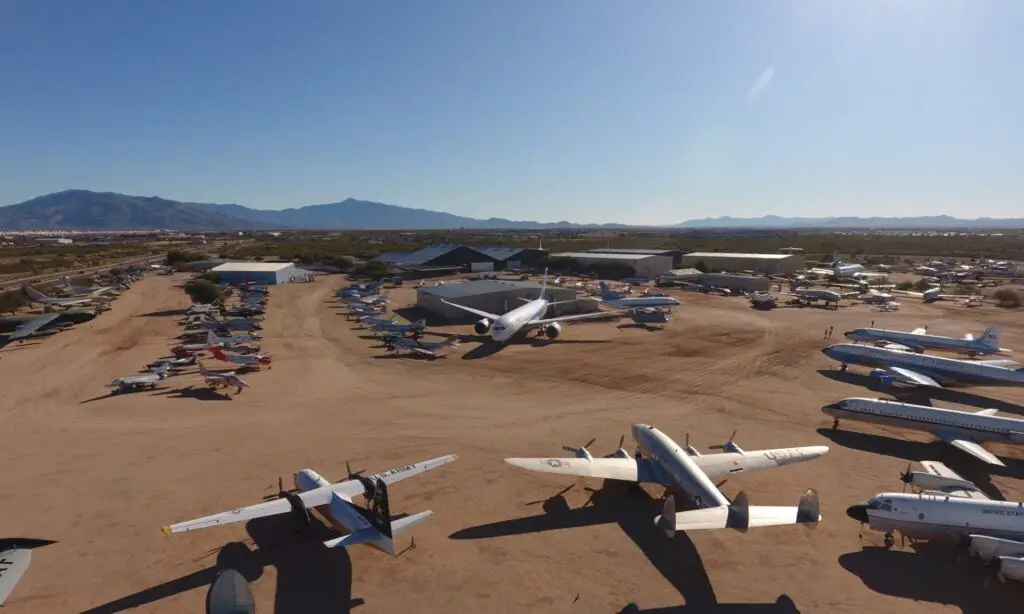Nestled in the vibrant city of Tucson, Arizona, within the sprawling expanse of the Tucson Mountain District, lies the renowned PIMA Air & Space Museum. As a beacon of aviation history, this museum boasts a rich collection of over 350 aircraft, spanning from the dawn of flight to the modern era of aerospace exploration. Situated just minutes away from downtown Tucson, the museum beckons visitors from far and wide to embark on a captivating journey through the skies and beyond.
Adjacent to the PIMA Air & Space Museum lies the captivating Saguaro National Park, home to the iconic Saguaro cactus and stunning desert landscapes that stretch across miles of untouched terrain. Nature enthusiasts can immerse themselves in the beauty of the Sonoran Desert while hiking, biking, or simply admiring the breathtaking vistas.
For those seeking a taste of the Old West, the nearby Old Tucson Studios offers a step back in time to the days of cowboys and gunfights. This renowned film studio and theme park recreate the ambiance of a frontier town, complete with live entertainment, stunt shows, and immersive Wild West experiences.
Just a stone’s throw away, the Arizona-Sonora Desert Museum provides a unique blend of zoo, botanical garden, and natural history museum, showcasing the diverse flora and fauna of the desert region. Visitors can encounter native wildlife, explore desert habitats, and gain insight into the delicate balance of desert ecosystems—all within the stunning backdrop of the Tucson Mountain District.
Table of Contents
History and Legacy
The history and legacy of the PIMA Air & Space Museum are deeply intertwined with the evolution of aviation itself. Founded in 1976, the museum was established with a mission to preserve, interpret, and educate the public about the rich heritage of aerospace technology and its profound impact on society. Over the decades, it has grown from a modest collection of aircraft to one of the largest aerospace museums in the world, attracting aviation enthusiasts, historians, and curious visitors from across the globe.
At the heart of the museum’s legacy is its dedication to honoring the achievements of pioneers in aviation and aerospace exploration. From the Wright brothers’ early experiments with powered flight to the groundbreaking advancements of the Space Age, the museum’s vast collection of aircraft and artifacts serves as a testament to human ingenuity and perseverance. Each aircraft tells a story—a testament to the courage of pilots, the brilliance of engineers, and the spirit of innovation that has propelled humanity to new heights.
Moreover, the museum’s commitment to education and outreach ensures that its legacy extends far beyond its physical walls. Through engaging exhibits, interactive displays, and educational programs, the museum inspires future generations to pursue careers in science, technology, engineering, and mathematics (STEM). By fostering a deeper understanding of aviation history and its relevance to contemporary issues, the museum continues to shape the minds of young learners and ignite a passion for exploration and discovery.
As the PIMA Air & Space Museum continues to evolve and expand, its history and legacy serve as a reminder of the enduring significance of flight in shaping the course of human history. From the humble beginnings of powered flight to the boundless frontiers of space exploration, the museum stands as a beacon of inspiration, inviting visitors to embark on a journey through the annals of aviation history and beyond.
Vast Collection
At the heart of the PIMA Air & Space Museum lies its crowning jewel: a vast and diverse collection of over 350 aircraft, spanning the entire spectrum of aviation history. From the earliest pioneers of flight to the cutting-edge innovations of modern aerospace engineering, this extensive collection offers visitors a comprehensive glimpse into the evolution of flight. Whether you’re a seasoned aviation enthusiast or a curious traveler with a passing interest in aircraft, the sheer breadth and depth of the museum’s collection are sure to inspire awe and wonder.
Some notable aircraft in the museum’s collection include:
- Lockheed SR-71 Blackbird: Often regarded as one of the most iconic aircraft ever built, the SR-71 Blackbird is a marvel of engineering and speed. With its sleek, black silhouette and unmatched performance capabilities, this reconnaissance aircraft played a crucial role in Cold War espionage and remains a symbol of American technological prowess.
- Boeing B-29 Superfortress: A towering symbol of World War II aviation, the B-29 Superfortress is best known as the aircraft that dropped the atomic bombs on Hiroshima and Nagasaki, hastening the end of the war. With its distinctive shape and formidable firepower, this massive bomber helped shape the course of history and remains a poignant reminder of the sacrifices made during the war.
- Boeing 747: Dubbed the “Queen of the Skies,” the Boeing 747 revolutionized air travel when it was introduced in the late 1960s. With its distinctive humpbacked design and spacious interior, the 747 ushered in a new era of long-haul flights and mass international travel, cementing its place as one of the most iconic passenger aircraft ever built.
- North American P-51 Mustang: Widely regarded as one of the finest fighter aircraft of World War II, the P-51 Mustang played a pivotal role in securing air superiority for Allied forces in Europe. With its exceptional speed, range, and maneuverability, the Mustang was instrumental in escorting Allied bombers deep into enemy territory and remains a beloved symbol of American aviation heritage.
- Space Shuttle Endeavour: As a symbol of human ingenuity and exploration, the Space Shuttle Endeavour represents the pinnacle of NASA’s Space Shuttle program. Having flown 25 missions, including assembly missions to the International Space Station, Endeavour has left an indelible mark on space exploration history. Visitors can marvel at the sheer size and complexity of this iconic spacecraft, gaining insight into the challenges and triumphs of space travel.
- Bell X-1: Known for breaking the sound barrier for the first time in level flight, the Bell X-1 holds a significant place in aviation history. Piloted by Chuck Yeager in 1947, this experimental aircraft pushed the boundaries of aerospace engineering and paved the way for supersonic flight. Its sleek design and groundbreaking achievements make it a standout artifact in the museum’s collection, offering visitors a glimpse into the daring feats of test pilots and the relentless pursuit of technological advancement.
- Consolidated B-24 Liberator: Another iconic bomber from World War II, the Consolidated B-24 Liberator played a crucial role in Allied operations, including strategic bombing campaigns in Europe and the Pacific. With its distinctive twin-tail design and impressive bomb load capacity, the B-24 was a workhorse of the Allied air forces, delivering devastating blows to enemy targets. Visitors can explore the interior of this historic aircraft, gaining a deeper appreciation for the courage and sacrifice of the men who flew them into battle.
Interactive Exhibits
At the PIMA Air & Space Museum, the experience goes beyond merely observing historic aircraft; visitors are invited to engage with a variety of interactive exhibits that bring the wonders of aviation and space exploration to life. These exhibits offer immersive and educational experiences, allowing guests to delve deeper into the principles of flight, the challenges of space travel, and the fascinating stories behind the artifacts on display. Whether you’re piloting a flight simulator, exploring a replica spacecraft, or experimenting with aerodynamics, the interactive exhibits at the museum provide hands-on learning opportunities for visitors of all ages.
Here are some notable interactive exhibits at the museum:
- Flight Simulators: Step into the cockpit and take control of a virtual aircraft with the museum’s flight simulators. Whether you’re soaring through the skies in a World War II fighter or piloting a modern commercial airliner, these realistic simulators offer an exhilarating experience that gives visitors a taste of what it’s like to be a pilot.
- Space Exploration Zone: Journey to the outer reaches of the cosmos in the Space Exploration Zone, where visitors can explore replicas of spacecraft, learn about the history of space exploration, and even experience what it’s like to walk on the surface of the moon. Interactive displays allow guests to simulate lunar landings, explore the planets of our solar system, and learn about the challenges of living and working in space.
- Aerodynamics Demonstrations: Discover the principles of flight with hands-on aerodynamics demonstrations that showcase the forces that enable aircraft to take to the skies. Visitors can experiment with wing designs, explore the concept of lift, and learn about the factors that affect an aircraft’s performance through interactive exhibits and educational displays.
- Engine Exhibits: Get up close and personal with the engines that power some of history’s most iconic aircraft. From piston engines to jet turbines, these exhibits provide a behind-the-scenes look at the technology that propels aircraft through the air. Visitors can learn about the inner workings of different engine types, explore the evolution of aviation propulsion, and even see engine components in action through interactive demonstrations.
- Flight Control Tower: Experience the thrill of air traffic control in the museum’s Flight Control Tower exhibit. Visitors can step into the shoes of an air traffic controller, managing the flow of aircraft in and out of a virtual airport. Using realistic simulations and interactive displays, guests can learn about the intricacies of air traffic management, communicate with pilots, and make split-second decisions to ensure the safe and efficient operation of the airspace. This exhibit offers a unique perspective on the vital role of air traffic control in keeping our skies safe and serves as a captivating introduction to the world of aviation operations.
Restoration Center
The Restoration Center at the PIMA Air & Space Museum stands as a testament to the meticulous care and dedication devoted to preserving aviation history. Nestled within the expansive museum grounds, this facility serves as a hub of activity where skilled craftsmen and passionate volunteers work tirelessly to restore vintage aircraft to their former glory.
Stepping into the Restoration Center is like stepping back in time, as visitors are greeted by the sights and sounds of aviation history being painstakingly brought back to life. From the iconic silhouettes of World War II bombers to the sleek lines of early jet fighters, the center is home to a diverse array of aircraft undergoing various stages of restoration.
Behind the scenes, a team of experts employs a combination of traditional craftsmanship and modern techniques to breathe new life into these historic artifacts. Whether it’s repairing battle damage, fabricating missing components, or meticulously repainting intricate insignias, every detail is carefully considered to ensure authenticity and historical accuracy.
What sets the Restoration Center apart is not just the technical expertise of its team, but also the passion and dedication they bring to their work. Many volunteers devote countless hours to restoring aircraft, drawn by a deep love for aviation and a desire to preserve these tangible links to the past for future generations.
Beyond its role in preserving aviation heritage, the Restoration Center also serves as an educational resource, offering visitors a glimpse into the complex process of aircraft restoration. Guided tours provide insight into the challenges and triumphs of restoring vintage aircraft, while interactive exhibits allow visitors to get hands-on experience with restoration techniques.
In essence, the Restoration Center is more than just a workshop—it’s a living tribute to the ingenuity, craftsmanship, and perseverance that have shaped the course of aviation history. As visitors witness firsthand the painstaking efforts required to restore these historic aircraft, they gain a deeper appreciation for the individuals and innovations that have propelled humanity to new heights.
Special Events and Programs
At the PIMA Air & Space Museum, the excitement doesn’t end with the static displays and interactive exhibits—special events and programs add an extra dimension to the visitor experience, offering unique opportunities to engage with aviation and space exploration in dynamic ways. Throughout the year, the museum hosts a diverse range of events and programs that cater to enthusiasts of all ages and interests, from thrilling air shows to educational workshops and family-friendly activities.
Here are some notable events and programs offered at the museum:
- Annual Aerospace Maintenance Competition: Witness the skill and precision of aviation maintenance professionals as teams from around the world compete in a series of challenges testing their expertise in aircraft maintenance, repair, and inspection. This high-energy event showcases the vital role of maintenance technicians in keeping aircraft safe and airworthy, while also providing valuable networking and professional development opportunities for participants.
- Night Wings: Experience the museum after dark during Night Wings, a special evening event featuring guided tours, live entertainment, and hands-on activities for the whole family. Visitors can explore the museum’s exhibits under the starry skies, participate in flashlight scavenger hunts, and even stargaze through telescopes provided by local astronomy clubs. With food trucks, music, and special guest appearances, Night Wings offers a fun and memorable way to experience the museum after hours.
- Aerospace Camp Experience (ACE): Inspire the next generation of aerospace professionals with the museum’s ACE program, a week-long summer camp designed for aspiring aviators and engineers ages 10-18. Participants have the opportunity to engage in hands-on activities, tour aerospace facilities, and meet industry professionals, gaining valuable insights into the world of aerospace technology and careers. From building model rockets to flying drones, ACE offers a comprehensive and immersive introduction to the wonders of flight and space exploration.
- Aviation History Lecture Series: Delve deeper into the fascinating world of aviation history with the museum’s Aviation History Lecture Series. Featuring renowned historians, authors, and aviation experts, these informative lectures cover a wide range of topics, from the early days of flight to the latest advancements in aerospace technology. Visitors can learn about famous aviators, historic aircraft, and pivotal moments in aviation history, gaining a deeper appreciation for the rich heritage preserved at the museum.
- STEM Education Workshops: Ignite a passion for science, technology, engineering, and mathematics (STEM) with the museum’s hands-on workshops and educational programs. Designed for students of all ages, these engaging workshops cover a variety of topics related to aviation and space exploration, allowing participants to explore concepts such as aerodynamics, rocketry, and robotics through interactive experiments and activities. Whether it’s building and launching model rockets or programming drones, these STEM workshops offer an exciting way for young learners to explore the principles of flight and space science.
- Veterans Day Tribute: Honor the brave men and women who have served in the armed forces with the museum’s Veterans Day Tribute event. Featuring special exhibits, military displays, and guest speakers, this annual event pays homage to the sacrifices and contributions of veterans from all branches of the military. Visitors can meet with veterans, hear their stories, and express their gratitude for their service, while also learning about the role of aviation in military history and national defense.
- Model Aircraft Expo: Let your imagination take flight at the museum’s Model Aircraft Expo, a celebration of scale modeling and miniature aviation. Model enthusiasts of all skill levels can showcase their creations, browse vendor booths, and participate in workshops and demonstrations covering topics such as scale modeling techniques, painting, and weathering. With contests, prizes, and opportunities to connect with fellow hobbyists, the Model Aircraft Expo offers a fun and creative outlet for aviation enthusiasts to share their passion for flight.
Visitor Experience
The visitor experience at the PIMA Air & Space Museum in Tucson, Arizona, transcends mere sightseeing, offering an immersive journey into the fascinating world of aviation history and technology. From the moment visitors step foot onto the museum grounds, they are enveloped in an atmosphere of wonder and discovery.
One of the highlights of the visitor experience is the sheer scale and diversity of the museum’s collection. With over 350 aircraft spanning nearly a century of aviation history, there is something to captivate enthusiasts of all ages and interests. From iconic warbirds like the B-17 Flying Fortress to cutting-edge fighter jets like the F-14 Tomcat, each aircraft tells a unique story of innovation, courage, and adventure.
Guided tours provide visitors with expert insights into the history and significance of the museum’s exhibits, offering a deeper understanding of the technological advancements and historical events that have shaped the course of aviation. For those who prefer to explore at their own pace, interactive exhibits and multimedia displays provide engaging opportunities to delve into various aspects of flight and space exploration.
Beyond the aircraft themselves, the museum offers a range of amenities and attractions to enhance the visitor experience. On-site dining options provide a welcome respite for hungry travelers, while gift shops offer a diverse selection of aviation-themed souvenirs and memorabilia to commemorate the visit.
Throughout the year, the museum hosts a variety of special events, from air shows and fly-ins to educational workshops and guest lectures. These events not only showcase the museum’s collection in dynamic ways but also foster a sense of community among aviation enthusiasts and visitors alike.
In every corner of the PIMA Air & Space Museum, visitors are invited to embark on a journey of discovery, exploration, and inspiration. Whether marveling at historic aircraft, engaging with interactive exhibits, or simply basking in the awe-inspiring beauty of human ingenuity, the visitor experience at the museum is truly unforgettable.
Conclusion
In conclusion, the PIMA Air & Space Museum in Tucson, Arizona, stands as a beacon of inspiration, education, and exploration for visitors from around the world. With its vast collection of historic aircraft, immersive interactive exhibits, and diverse array of special events and programs, the museum offers a captivating journey through the annals of aviation and space exploration. From the earliest pioneers of flight to the cutting-edge innovations of modern aerospace technology, each artifact tells a story of human ingenuity, courage, and perseverance, inviting visitors to marvel at the wonders of the skies and beyond.
As visitors explore the museum’s exhibits, participate in educational programs, and engage with fellow enthusiasts, they are not only experiencing the thrill of aviation history but also contributing to its preservation and legacy. The PIMA Air & Space Museum serves as a living tribute to the pioneers, aviators, engineers, and astronauts who have shaped the course of human history through their passion for flight and exploration. Whether you’re a seasoned aviation enthusiast, a curious traveler, or a budding young scientist, the museum offers something for everyone, inspiring wonder, curiosity, and a deeper appreciation for the boundless possibilities of the human spirit.







